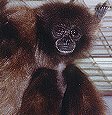 Meet Penny, one of IPPL's
Sanctuary Gibbons
Meet Penny, one of IPPL's
Sanctuary Gibbons
MEETING THE WOOLLY MONKEYS OF CORNWALL
by IPPL Chairwoman Shirley McGreal
In September 1998, I was in England to attend the conference of the Species Survival Network held at Oxford University. After the conference I visited two wonderful facilities, the Woolly Monkey Sanctuary in Looe, Cornwall and Monkey World in Dorset.
The Woolly Monkey Sanctuary was established in 1964 by the late Leonard Williams. It occupies a spectacular hillside property overlooking the ocean. The founder monkeys were mainly ex-pets. In general, woolly monkeys fare badly in captivity, but there are now 4th generation Cornwall-born monkeys. Woolly monkeys are large South American primates with thick prehensile tails.
Since Williams' death, the Woolly Monkey Sanctuary has been run as a cooperative by the animal caregivers.
The 16 resident monkeys have extensive outdoor housing as well as indoor units. Many are allowed to play in the trees on the premises. The monkeys forage and obtain much of their own food. The rest of their diet is fresh local produce.
Visitors are given talks about the Looe monkeys and about the plight of the woolly monkeys of the Amazon, who are hunted for food and the pet trade. They are also told why primates should not be kept as pets.
A museum educates visitors about the problems of wild woolly monkeys and the history of the sanctuary.
Besides carrying on its work in Cornwall, the sanctuary is expanding its work to include care of confiscated woolly monkeys in South America and hopes to possibly return all or some of the Cornwall-born monkeys to the wild, most probably in Brazil.
There are also plans to "twin" schools in Britain with schools in South America so that young people of these nations can interact.
The Sanctuary statement of aims includes the following statement:
Our attitude towards the monkeys is very different from that of many places keeping animals in captivity. Our approach is to respect each monkey as an individual with individual needs and to regard their physical and emotional needs as being perfectly adapted to the rain-forest rather than to captivity.
In fact we are basically opposed to the concept of animals in captivity and we try to be realistic and honest in ourexplanation of the Sanctuary to visitors.
Among the sanctuary monkeys was a blind monkey named Laura. This gentle monkey knew her way around the sanctuarygrounds. It was interesting to compare her with IPPL's blind gibbon Beanie, also very skilled in finding his way around familiar areas.
The visitors to the sanctuary seemed unlike the visitors at regular zoos. They were quiet and respectful and listened carefullyto the excellent presentations given by the caregivers. Not one visitor I saw made any attempt to feed the monkeys rubbish.
Thanks to Health Care Co-ordinator, Rachel Hevesi, Research Co-ordinator Jordi Casamitjana, and everyone at theWoolly Monkey Sanctuary for their wonderful welcome!
Jordi is such an excellent and articulate talker that, to raise funds, he once talked non-stop for 14 hours!
Be sure to visit the Woolly Monkey Sanctuary is you
are ever in Cornwall.
 Meet Penny, one of IPPL's
Sanctuary Gibbons
Meet Penny, one of IPPL's
Sanctuary Gibbons